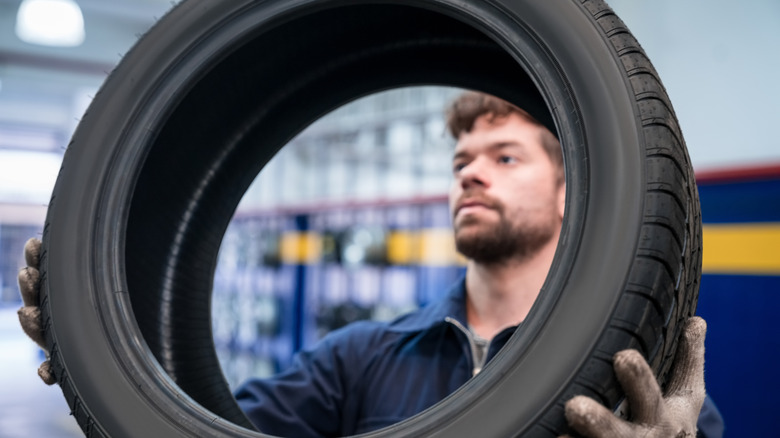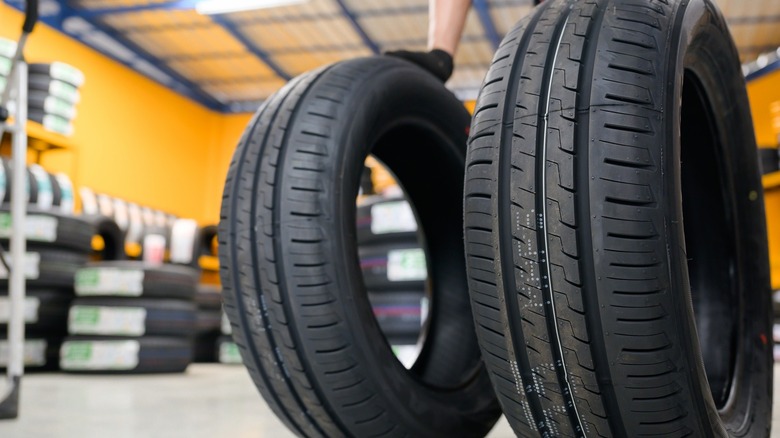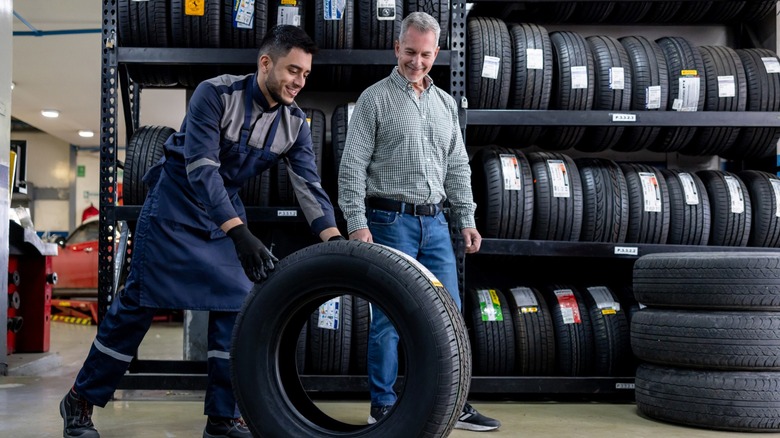Here's Why You Should Always Change Your Car Tires In Pairs
No matter type of car you drive, the tires are really important. The grip and traction your tires provide determine how smooth it is to accelerate, steer, and bring your car to a quick stop. But just as with any car part, tires wear and tear. And it's tempting to replace only the ones that seem the most worn out, seeing as new tires cost a pretty penny. After all, why invest in all four when just one or two seem to be the problem?
Well, mixing one new tire with three older ones can throw off your car's balance, making its handling weird and potentially putting you in a risky spot on the road. Now, we totally get that not everyone has the cash to throw down on a brand-new set all at once. But here's the deal — safety first, always. Skimping on safety costs more in the long run. However, what can you, as a budget-conscious driver, do? If you can't change all four, the next best move is to replace your tires two at a time. And here are all the reasons why.
Why change tires in pairs?
Let's put why your car has four tires into perspective. They're not just there to make your car look complete; they're crucial for distributing the weight of your car evenly and ensuring that you have control at all times. Whether you're braking, accelerating, or cornering, your tires are what keep you from sliding off the road.
When tires wear down, they usually do so unevenly. Your front tires might wear out faster on a front-wheel drive since they handle most of the steering and braking pressure. On the other hand, for a rear-wheel drive, the rear tires might wear out quicker due to them pulling most of the acceleration weight.
Replacing just one tire messes up your car's balance and handling. Changing the tires in pairs is the safest way to maintain balance and ensure that the handling isn't so weird. And it's not even just a performance issue; it's also a safety concern. Imagine driving on a wet road, and your tires don't have equal levels of tread depth. Your car might not be able to handle as predictably, and without a stable grip, you could lose control.
Things to consider before changing the tires
While it's true that buying two tires might seem like a huge dent in your budget, it can actually save you money and hassle in the long run. Tires that wear evenly tend to last longer, meaning you won't have to replace them as frequently. Plus, maintaining good tires improves your car's fuel efficiency, saving you money at the pump.
But how do you know when it's time to replace your tires? There will be physical indicators like some bald spots here and there. Also, you might be able to tell from how your car moves. So, every time you're behind the wheel, pay attention to how the car handles. If it's not as responsive, or if it slides more easily on slippery roads, it might be the signal you need to get a replacement. Even manufacturers recommend changing your tires after about five or six years.
When you're ready to replace your tires, make sure you're choosing the right ones for your car, the season, and the terrain. First of all, what works for a sports sedan won't work for a family SUV. Also, you can't just choose any brand. The new tires have to match the old ones. And you shouldn't be mixing summer tires with all-season tires.
Do the new tires go to the front or to the rear? Well, it depends on the level of wear and tear and the tread depths. However, it's best practice to move the rear tires to the front and have the new ones go in the rear. When in doubt, consult a professional who can guide you in making the best choice for your car.


